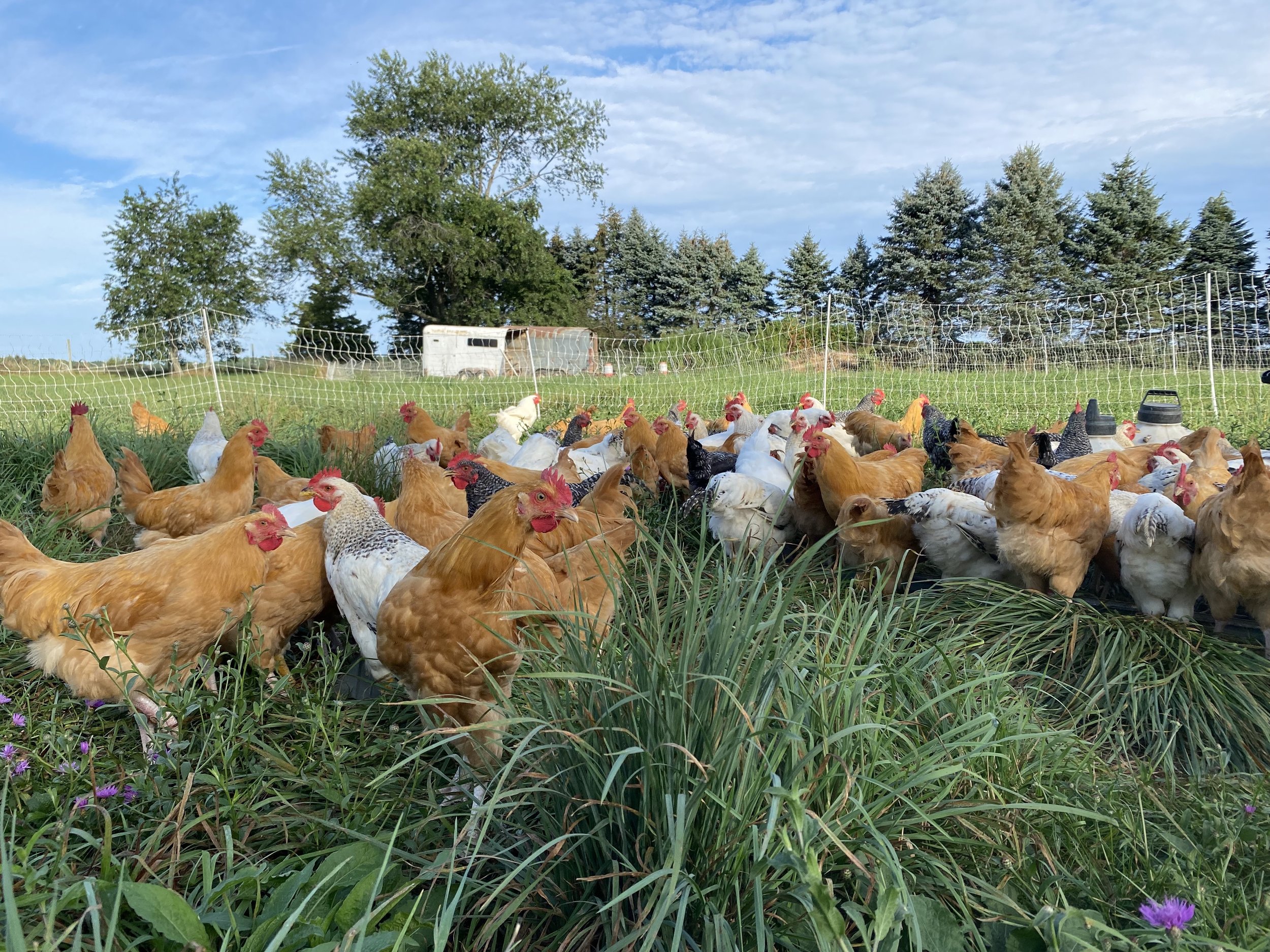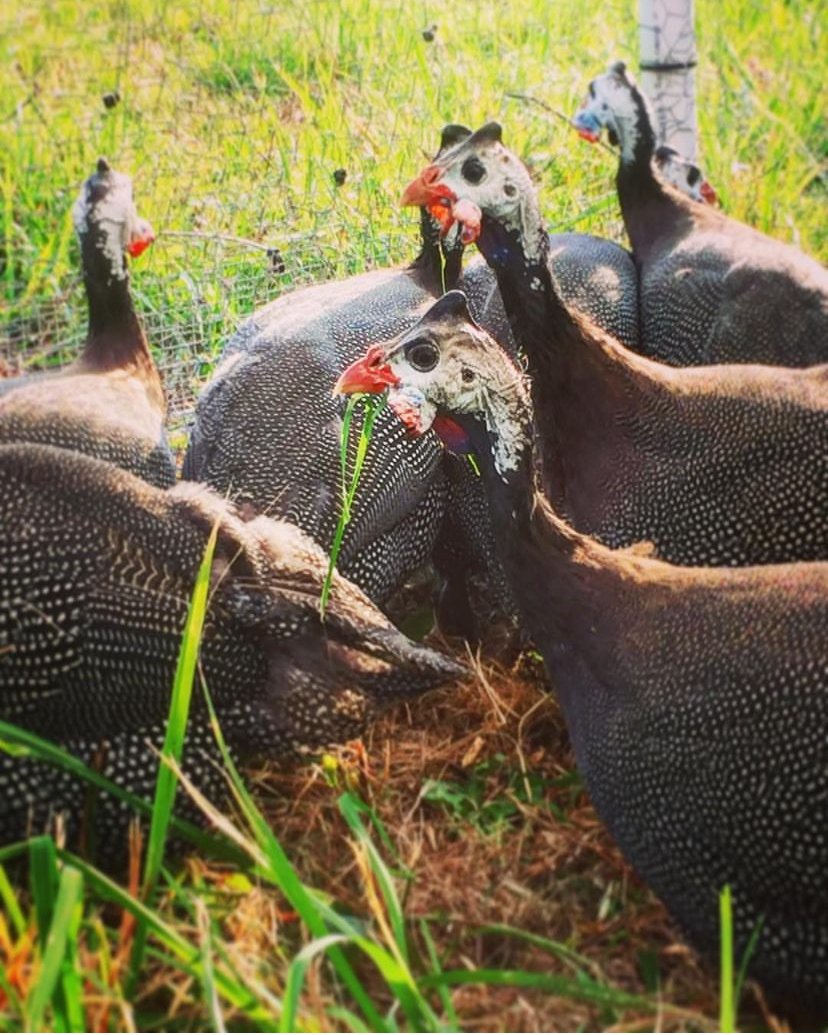Birds We Raise
Birds We Raise
While quail is what we are known for, we have branched out into other species of game birds and specialty poultry to offer a variety of freshly harvested meats, offal, stock bones, and more. All of our birds are raised on pasture. The cost of our meat and eggs directly reflects the quality of care, feed, and living conditions we upkeep daily. In an effort to cut down on locally produced food waste and dependence upon grain, we source food scraps to be fed to our birds from local restaurants, farm stands, and stores. All of our supplemental feed is freshly mixed for our flocks on a weekly basis by a local mill and delivered direct to our farm.
In 2022, Feisty Acres became one of fifteen inaugural farms in the country to join the Good Shepherd Conservancy in an effort to preserve heritage/standard bred breeds of poultry and normalize their availability in the modern poultry industry. Our heritage and standardbred chicken and turkeys originate from genetics of the Good Shepherd Poultry Ranch owned and operated by Frank Reese Jr. These genetic lines have been bred with emphasis on good meat production, slower growth rates that encourage proper muscle and bone development, as well as even-keeled temperaments.
Find below brief descriptions of our fine-feathered fowl!
** WE DO NOT SELL LIVE BIRDS, CHICKS, OR HATCHING EGGS**
Two Coturnix hens check out their nest box.
Coturnix aka japanese quail
This species of quail originated in east Asia and also goes by the name "Old World Quail" and sometimes "Nile Quail." The earliest written record of their domestication is in 12th century Japan and they were originally kept for their unique song. More recently bred for meat and egg production, these quail can lay up to 300 eggs in a year. When processed for meat, they average between 6 - 8 ounces. The entire bird consists of richly flavored dark meat. They reach market weight in 8 - 10 weeks. AVAILABILITY: Meat - July through December, Eggs - intermittent through the season
Silkie chickens enjoying pasture life.
Silkie chicken
While these birds are not a game bird, we raise these unusual chickens for their prized gray-black skin, meat, and bones. They are also known as "polydactyls" which means that they have five toes rather than four. Most often recognized in asian cuisines, silkie chickens have gained a following here in America as their meat and bones are essential ingredients in soups, stews, curries, and bone broth. When processed for meat, average weight is between 1.5 - 2 pounds. They take 12 - 14 weeks to reach market weight. AVAILABILITY: Meat - June through October in limited amounts
Heritage/Standardbreed cockerels.
Heritage/Standard bred Chicken
These chickens reach market weight anywhere between 13 - 16 weeks. They have firmer muscle structure, denser bones, and plenty of yellow fat. Wonderful slow roasted, braised, curried, used in a soup or hearty stew. As per the Livestock Conservancy, the definition of heritage/ standard bred breeds are as follows:
Heritage Chicken must adhere to all the following:
APA Standard Breed
Heritage Chicken must be from parent and grandparent stock of breeds recognized by the American Poultry Association (APA) prior to the mid-20th century; whose genetic line can be traced back multiple generations; and with traits that meet the APA Standard of Perfection guidelines for the breed. Heritage Chicken must be produced and sired by an APA Standard breed. Heritage eggs must be laid by an APA Standard breed.Naturally mating
Heritage Chicken must be reproduced and genetically maintained through natural mating. Chickens marketed as Heritage must be the result of naturally mating pairs of both grandparent and parent stock.Long, productive outdoor lifespan
Heritage Chicken must have the genetic ability to live a long, vigorous life and thrive in the rigors of pasture-based, outdoor production systems. Breeding hens should be productive for 5-7 years and roosters for 3-5 years.Slow growth rate
Heritage Chicken must have a moderate to slow rate of growth, reaching appropriate market weight for the breed in no less than 16 weeks. This gives the chicken time to develop strong skeletal structure and healthy organs prior to building muscle mass.AVAILABILITY: Meat - June through December
Our mixed flock of egg laying chickens, consisting of both heritage and hybrid breeds.
Egg Laying Chickens
Our flock of egg laying hens are out on pasture all year round. We supplement their forage with locally milled feed, and food scraps from restaurants, farm stands and stores. Eggs are sold by the dozen only. AVAILABILITY: Eggs - All year round with seasonal fluctuations
A close up of one of our red broiler chickens on pasture.
Cornish Cross broilers at about 7 weeks of age.
Broiler chicken
We raise two varieties of hybrid broiler chickens on the farm: red broilers and cornish cross broilers. Both varieties are wonderful for baking, roasting, frying, grilling or any other cooking method. They’re highly versatile. Cornish cross broilers reach a market weight of between 3-5 pounds in 7-8 weeks. Red broilers achieve a market weight of around 4 pounds at 9-10 weeks. Whole birds and limited amounts of cuts available. AVAILABILITY: Meat - April through December
French Guinea Hens are excellent foragers of seeds, grasses, and insects.
French Guinea Hen
This breed of guinea hen reaches weights 1-2 pounds larger than common guinea hens found on the market today. Their meat is dark with pleasant amounts of intramuscular fat. Excellent for roasting and braising. French guinea hens reach market weight in about twelve weeks.
AVAILABILITY: Meat - June through December
Profile of one of our Bourbon Red turkeys. Photo Courtesy of Go North Fork
Heritage Breed turkey
Heritage turkeys are defined (as per The Livestock Conservancy) by the historic, range-based production system in which they are raised. Turkeys must meet all of the following criteria to qualify as a Heritage turkey:
1. Naturally mating: the Heritage Turkey must be reproduced and genetically maintained through natural mating, with expected fertility rates of 70-80%. This means that turkeys marketed as “heritage” must be the result of naturally mating pairs of both grandparent and parent stock. Their industrial counterparts, the broad breasted bronze and the broad breasted white, cannot do this and therefore not considered "heritage" breeds.
2. Long productive outdoor lifespan: the Heritage Turkey must have a long productive lifespan. Breeding hens are commonly productive for 5-7 years and breeding toms for 3-5 years. The Heritage Turkey must also have a genetic ability to withstand the environmental rigors of outdoor production systems.
3. Slow growth rate: the Heritage Turkey must have a slow to moderate rate of growth. Today’s heritage turkeys reach a marketable weight in about 28 weeks, giving the birds time to develop a strong skeletal structure and healthy organs prior to building muscle mass.
For the 2019 season we will be raising Black Spanish, Bourbon Red, & Narragansett. AVAILABILITY: Meat - Thanksgiving ONLY
Broad breasted Bronze turkeys are friendly with a better than average foraging instinct among hybrid breeds.
Broad breasted bronze turkey
A fast growing variety of turkey that reaches weights between 12 - 20 pounds in 16-18 weeks. They have plentiful breast meat and lots of fat to keep everything juicy during cooking. Friendly and good foragers for a hybrid breed, broad breasted bronze turkeys are a reliable holiday staple on the farm. AVAILABILITY: Meat - Thanksgiving ONLY








